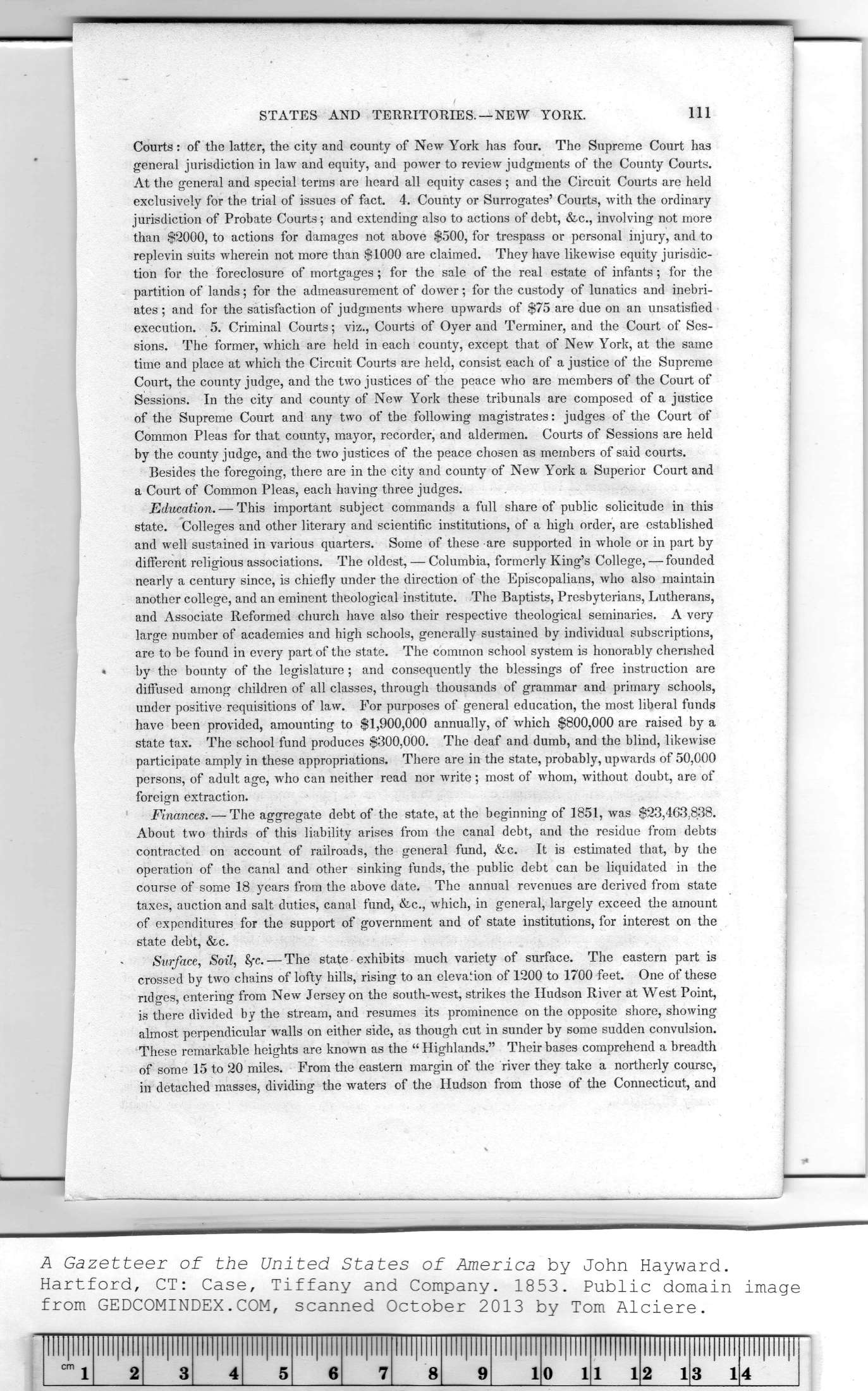|
|
Note: Ctrl and + increases the font size of the text below, Ctrl and - decreases it, and Ctrl and 0 resets it to default size.
STATES AND TERRITORIES.—NEW YORK. Ill
Courts : of the latter, the city and county of New York has four. The Supreme Court has
general jurisdiction in law and equity, and power to review judgments of the County Courts.
At the general and special terms are heard all equity cases ; and the Circuit Courts are held
exclusively for the trial of issues of fact. 4. County or Surrogates' Courts, with the ordinary
jurisdiction of Probate Courts; and extending also to actions of debt, &c., involving not more
than $2000, to actions for damages not above $500, for trespass or personal injury, and to
replevin suits wherein not more than $1000 are claimed. They have likewise equity jurisdic-
tion for the foreclosure of mortgages ; for the sale of the real estate of infants ; for the
partition of lands ; for the admeasurement of dower ; for the custody of lunatics and inebri-
ates ; and for the satisfaction of judgments where upwards of $75 are due on an unsatisfied
execution. 5. Criminal Courts; viz., Courts of Oyer and Terminer, and the Court of Ses-
sions. The former, which are held in each county, except that of New York, at the same
time and place at which the Circuit Courts are held, consist each of a justice of the Supreme
Court, the county judge, and the two justices of the peace who are members of the Court of
Sessions. In the city and county of New York these tribunals are composed of a justice
of the Supreme Court and any two of the following magistrates: judges of the Court of
Common Pleas for that county, mayor, recorder, and aldermen. Courts of Sessions are held
by the county judge, and the two justices of the peace chosen as members of said courts.
Besides the foregoing, there are in the city and county of New York a Superior Court and
a Court of Common Pleas, each having three judges.
Education. — This important subject commands a full share of public solicitude in this
state. Colleges and other literary and scientific institutions, of a high order, are established
and well sustained in various quarters. Some of these are supported in whole or in part by
different religious associations. The oldest, — Columbia, formerly King's College, — founded
nearly a century since, is chiefly under the direction of the Episcopalians, who also maintain
another college, and an eminent theological institute. The Baptists, Presbyterians, Lutherans,
and Associate Reformed church have also their respective theological seminaries. A very
large number of academies and high schools, generally sustained by individual subscriptions,
are to be found in every part of the state. The common school system is honorably cherished
by the bounty of the legislature ; and consequently the blessings of free instruction are
diffused among children of all classes, through thousands of grammar and primary schools,
under positive requisitions of law. For purposes of general education, the most liberal funds
have been provided, amounting to $1,900,000 annually, of which $800,000 are raised by a
state tax. The school fund produces $300,000. The deaf and dumb, and the blind, likewise
participate amply in these appropriations. There are in the state, probably, upwards of 50,000
persons, of adult age, who can neither read nor write; most of whom, without doubt, are of
foreign extraction.
Finances. — The aggregate debt of the state, at the beginning of 1851, was $23,463,838.
About two thirds of this liability arises from the canal debt, and the residue from debts
contracted on account of railroads, the general fund, &c. It is estimated that, by the
operation of the canal and other sinking funds, the public debt can be liquidated in the
course of some 18 years from the above date. The annual revenues are derived from state
taxes, auction and salt duties, canal fund, &c., which, in general, largely exceed the amount
of expenditures for the support of government and of state institutions, for interest on the
state debt, &c.
Surface, Soil, 8fc. — The state exhibits much variety of surface. The eastern part is
crossed by two chains of lofty hills, rising to an elevation of 1200 to 1700 feet. One of these
ridges, entering from New Jersey on the south-west, strikes the Hudson River at West Point,
is there divided by the stream, and resumes its prominence on the opposite shore, showing
almost perpendicular walls on either side, as though cut in sunder by some sudden convulsion.
These remarkable heights are known as the “ Highlands." Their bases comprehend a breadth
of some 15 to 20 miles. From the eastern margin of the river they take a northerly course,
in detached masses, dividing the waters of the Hudson from those of the Connecticut, and
A Gazetteer of the United States of America by John Hayward.
Hartford, CT: Case, Tiffany and Company. 1853. Public domain image
|
